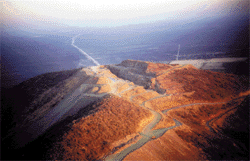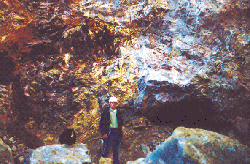 |
52 (4) (2000), pp. 17-20. |
|---|
Microtextural Mineralogy: Overview
 |
52 (4) (2000), pp. 17-20. |
|---|
|
TABLE OF CONTENTS |
|---|
|
|
 |
|
Figure 1. The new B open pit at the summit of Okorusu Mountain at the Okorusu mine. |
Recent field mapping in two open pits at the Okorusu fluorspar mine in Namibia confirmed the presence of a variety of host rocks that were replaced by fluorite ores. The presence of certain textures in the fluorite ores can be used to identify the original host rock that was replaced. The character of the original host rock prior to fluorite replacement, in turn, has a significant controlling influence upon the beneficiation problems that are experienced for those ores.
The fluorspar ores at Okorusu, Namibia, are associated with
an alkaline igneous-carbonatite ring dike complex.1–7
The complex is probably of early Cretaceous age, and it intrudes into late Pre-cambrian
Damara Series regionally metamorphosed quartzites, marbles, and biotite schists.
The metasedimentary rocks have been thoroughly fenitized in the vicinity of
the igneous intrusives to fine-grained sodic fenites. The fenites consist of
aegirine-augite, titaniferous magnetite, and calcite. The early main intrusion
of carbonatite (sövite) is fine grained and consists almost entirely of calcite.
Recent mapping at both the A and B pits (Figure
1) at Okorusu discovered late pegmatitic-carbonatite intrusive rocks. Such
rocks were commonly replaced by fluorspar ores, the textures of which can be
used to provide insights into the various types of beneficiation problems associated
with these ores.
Although a single, bottle-shaped pod of pegmatitic carbonatite
had formerly been recognized in the A pit at the Okorusu fluorspar mine, recent
mapping has shown that pegmatitic carbonatite is commonly present as pods,
dikes, and veinlets that intrude the sodic fenitized metasedimentary rocks.
The pegmatitic carbonatite predominantly consists of coarsely crystallized calcite
(crystals up to 10 cm across), abundant euhedral magnetite crystals (crystals
as much as 13 cm across), common apatite (often in radial acicular whorls),
and platy pyrite/pyrrhotite crystals.
Rocks, formerly called coarse-grained sodic fenites, are associated with the pegmatitic carbonates. They contain all of the minerals present in the pegmatitic carbonates, together with abundant, coarse-grained aegirine-augite, and are perhaps better termed silicocarbonatites or replacement carbonatites. Cathodoluminescence (CL) microscopy is an excellent tool for the study of the carbonatites, due to the purple CL of the apatite and the yellow CL shown by the calcite (Figure 2).
Magnetite Rims
Where the pods of fluorite ore were formed by the replacement
of pegmatitic carbonatite, remnants of the partly replaced to unreplaced carbonatite
may locally remain to attest to the character of the replaced rock (Figure
3a and Figure 3b). More commonly,
however, all traces of the calcite in the original pegmatitic carbonatite are
replaced by fluorite, and only titaniferous magnetite rims and goethite pseudomorphs
after original iron-bearing minerals remain to attest to the fact that the original
replaced rocks were pegmatitic carbonatite.
Titaniferous magnetite is a persistent constituent in the pegmatitic carbonatites,
deposited as very coarse (up to 13 cm long) euhedral crystals, especially at
the margins, to form rims around the carbonatite pods and veinlets. After the
coarse calcite was replaced by fluorite, the titaniferous magnetite rims remain
as partly martitized magnetite rims around the fluorite ore pods.
Goethite Pseudomorphs after Magnetite and Aegirine-Augite Crystals
Titaniferous magnetite also occurs as coarse crystals disseminated throughout the pegmatitic carbonatite. During replacement of the pegmatitic carbonatite by fluorite, the disseminated magnetite crystals were oxidized to equant goethite pseudomorphs after the magnetite crystals. Similarly, large prismatic crystals of aegirine-augite most commonly occur near the margins of the pegmatitic pods, and they are oxidized to prismatic goethite pseudomorphs after the original pyroxene prisms.
Goethite Pseudomorphs after Platy Pyrite/Pyrrhotite
One of the most interesting textures present in some of the
Okorusu fluorspar ore is that of large, platy crystal shapes composed of goethite.
Recent mapping has revealed the presence of platy pyrite in the pegmatitic carbonatite,
and it is now evident that platy goethite in the fluorite ores formed by the
oxidation of platy pyrite in the pegmatitic carbonatite during their replacement
of the fluorite ores.
Initial ore microscopic study of the pyrite showed that it formed as a replacement
of pyrrhotite, which derived its platy character by the partial to complete
replacement of large plates of mica in the original pegmatitic carbonatite.
The alteration of pyrrhotite to pyrite is accompanied by secondary magnetite;
its texture is similar to that developed during serpentinization of pentlandite-pyrrhotite
nickel ores in mafic and ultramafic igneous rocks.
Banded or Planar Features and Small Flat Vugs
Other textures present in the fluorite ores that indicate their
origin are local-banded or planar features and the associated abundant small
flat vugs. Although the massive replacement fluorite ores typically lack fluorite
alignment features, a general tendency toward alignment textures is locally
present. Such features are 15–30 cm long and consist of several parallel alignments.
The directions of such alignments vary greatly over mine exposures 3–9 m wide.
These planar features typically are associated with abundant apatite, and they
appear to have developed by fluorite deposition on alignments of apatite, probably
remnant from the replaced pegmatitic carbonatite. Finally, pods of fluorite
ore that have replaced pegmatitic carbonatite may contain abundant vugs, perhaps
developed as a result of the great susceptibility of the carbonatite calcite
to fluorite replacement.
Phosphate Beneficiation Problems
All of the above textural features are clues to the fact that the original rock types were pegmatitic carbonatites. The importance of recognizing the replaced rock type lies in the fact that the pegmatitic carbonatite typically contains large amounts of apatite, and much of this apatite remains in the fluorite ore as an insoluble residue. Therefore, fluorite ores that have replaced pegmatitic carbonatite in the ore tend to be high in apatite content.
This may commonly lead to high phosphorus in the fluorite concentrates
in the form of locked apatite-fluorite particles.8–10
These beneficiation problems are especially important for fluorite ores in the
A pit, but also are important for some of the ores in the B pit.
|
|
 |
|
Figure 4. Fluorite ore (left) showing vertical foliation inherited from the replacement of marble and biotite schist (right) (B pit, 1660 level, footwall, Okorusu mine). |
Pegmatitic Carbonatite Cemented Sodic Fenite Breccias
The pegmatitic carbonatite commonly formed a cement for brecciated sodic fenite. Where the fluorite ores replaced pegmatitic carbonatite-cemented fenite breccias, the fluorite pods locally show a texture involving breccia fragments of sodic fenite toward the margins of the fluorite pods. Such ore pods also are commonly characterized by nearby veinlets of unreplaced pegmatitic carbonatite. Where fluoriteore mineralization extends beyond magnetite rims and forms replacements of fine-grained sodic fenite, the ores are characterized by a lack of magnetite rims and the presence of narrow zones of tan hydrothermal potassic alteration.
Marbles and Biotite Schists
Some of the fluorspar ores (B band) in the B pit have replaced marbles and biotite schists. These ores are characterized by strong foliation textures relict from the foliation of the replaced metasediments (Figure 4). Where those metasediments contained potash feldspar, the fluorite concentrates have elevated silica contents due to the presence of binary locked potash feldspar-fluorite particles. Thus, the potential for silica beneficiation problems can be predicted by recognizing that the fluorite ores have replaced marbles and, especially, biotite schist.10
1. P.J. Van
Zijl, “The Geology, Structure and Petrology of the Alkaline Intrusions of Kalkfeld
and Okorusu and the Invaded Damara Rocks,” Annale van die Universiteit van
Stellenbosch, 37A (4) (1962), pp. 241–338.
2. P. Prins, “The Geochemical Evolution of the Alkaline and Carbonatite Complexes
of the Damaraland Igneous Province, South West Africa,” Annale van die Universiteit
van Stellenbosch, Series A1 (Geol.), 3 (1981), pp. 145–278
3. A.I. Kogut, R.D. Hagni, and G.I.C. Schneider, “The Okorusu, Namibia Carbonatite-Related
Fluorite Deposits: Comparison with the Southern Illinois-Kentucky Fluorite District,”
Carbonate-Hosted Lead-Zinc Deposits, 75th Anniversary volume, ed. D.F.
Sangster (Littleton, CO: Soc.
Economic Geologists, 1996), pp. 290–297.
4. A.I. Kogut, R.D. Hagni, and G.I.C. Schneider, “Geology, Mineralogy, and Paragenetic
Sequence of the Okorusu Carbonatite-Related Fluorite Ores, Namibia,” Proc. Ninth
IAGOD Symp., Int. Association on the Genesis of Ore Deposits, ed. R.D.
Hagni (Stuttgart, Germany: E. Schweizerbart’sche Verlagsbuchhandlung, 1996),
pp. 555–573.
5. A.I. Kogut, R.D. Hagni, and G.I.C. Schneider, “Geology, Mineralogy, and Geochemistry
of the Carbonatite-Related Fluorite Ores at Okorusu, North-Central Namibia,
Studies on Ore Deposits,” Mineral Economics, and Applied Mineralogy: With
Emphasis on Mississippi Valley-type Base Metal and Carbonatite-Related Fluorspar
Deposits, ed. R.D. Hagni (Rolla, MO: Univ.
Missouri Press, in press).
6. R.D. Hagni, “Variations in Ores, Host Rocks, and Ore Controls for the Carbonatite-Related
Fluorspar Deposits at Okorusu, North-Central Namibia,” Studies on Ore Deposits,
Mineral Economics, and Applied Mineralogy: With Emphasis on Mississippi Valley-type
Base Metal and Carbonatite-Related Fluorspar Deposits, ed. R.D. Hagni (Rolla,
MO: Univ. Missouri
Press, in press).
7. P.A. Shivdasan and R.D. Hagni, “Okorusu Fluorspar Deposits, Okorusu, Namibia:
Preliminary Results of 1999 Field Mapping,” Mineral Economics, and Applied
Mineralogy: With Emphasis on Mississippi Valley-type Base Metal and Carbonatite-related
Fluorspar Deposits, ed. R.D. Hagni (Rolla, MO: Univ.
Missouri Press, in press).
8. A.I. Kogut and R.D. Hagni,
“Mineralogical Characterization of Phosphorus in Fluorite Ores and Concentrates
from Southern Africa,” Process
Mineralogy XIII: Applications to Beneficiation Problems, Pyrometallurgical Products,
Advanced Mineralogical Techniques, Precious Metals, Environmental Concerns,
Ceramic Materials, Hydrometallurgy, and Minerals Exploration, ed. R.D.
Hagni (Warrendale, PA: TMS, 1995), pp. 15–
27.
9. R.D. Hagni and A.I. Kogut, “The Character of Phosphorus in Fluorite Ores
and Concentrates from the Okorusu Fluorite Deposit, North-Central Namibia,”
Proc. 5th International Congress on Applied Mineralogy in the Minerals Industry
(Warsaw, Poland: 1996), pp. 216–220.
10. R.D. Hagni, “Mineralogy
of Beneficiation Problems Involving Fluorspar Concentrates from Carbonatite-Related
Fluorspar Deposits,” J. Mineralogy and Petrology (in print).
Richard D. Hagni and Purnima A. Shivdasan are with the Department of Geology and Geophysics at the University of Missouri–Rolla.
For more information, contact R.D. Hagni, Department of Geology
and Geophysics, University of Missouri–Rolla, Rolla, Missouri 65409- 0410; (573)
341-4657; fax (573) 341-6935; e-mail rhagni@umr.edu.
Direct questions about this or any other JOM page to jom@tms.org.
| If you would like to comment on the April
2000 issue of JOM,
simply complete the JOM on-line critique form |
|||||
|---|---|---|---|---|---|
| Search | TMS Document Center | Subscriptions | Other Hypertext Articles | JOM | TMS OnLine |